Steven Universe: The Rise of Popularity in Internet Fandoms
Over the past several years there has been an insurgence of cartoons that have captured the hearts and attention of viewers of all ages across the internet. From Avatar: The Last Airbender and its impeccable world building and enrapturing plot, to Adventure Time with its surrealist humor and bright animation, it’s become more and more common for cartoons to no longer be considered ‘kids’ stuff,’ and grab the attention of older viewers. And over the past few years more and more talented and creative shows have joined the ranks. Shows such as Legend of Korra, Gravity Falls, and Over the Garden Wall have been the talk of many social media networks.
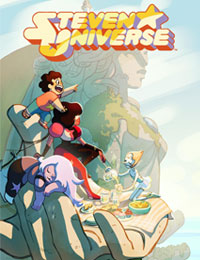
Among these shows a new favorite has begun to emerge over the past few months, a bright little cartoon called Steven Universe.
The show takes place in a world much like our own, in a small beach city full of pastel colors and soothing backgrounds. Its main character is a young boy named Steven, who is a part of the ‘Crystal Gems’, a group of women that fight off alien, gem-based invaders. Steven, fulfilling the role of his lost mother (who was the leader of the Crystal Gems), lives with the three gem and light based beings, Garnet, Amethyst, and Pearl. It’s a short action adventure show, packed full of humor and creativity.
But it may come as a surprise to know that this show isn’t actually new.
Steven Universe began in 2013, and only just recently started its second season. While there was a following for the show, it was at the end of the first season that its popularity really blew up.
So why exactly did this small show become the center of so many people’s attention? What about it grabbed people so fiercely? And why now, two years after it’s been on the air?
The overall consensus seems to be the same thing that drew people to so many other cartoons: The creative ideas, unique perspective, and storylines that audiences can engage in. Even among so many strong shows, Steven Universe is managing to make a name for itself using a clever style, likable and realistic characters, a unique mystery, a unique perspective on gender and sexuality, and a lot of heart.
(Warning: Some vague spoilers for the show are discussed in this article.)
Animation Style
At this point in the game, most know that style is important for any show to get popular, but this is especially true for cartoons. The nature of animation means that creators have to put forth some of their best artistic effort at all times if they want any chance of drawing in audiences. Artistic style is the basis of any cartoon series as it’s the first thing an audience notices when the show starts, and it’s what saturates and sets the tone for the entire series.
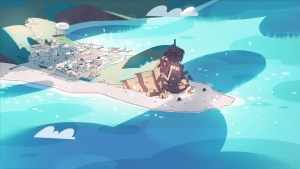
Adventure Time for example is saturated in bright, surrealistic colors and designs; fitting for the manic world it takes place in. Just from that people can take a good guess at what they are going to get in terms of stylistic storytelling and humor. Gravity Falls on the other hand is steeped in dark shadows and sharp angles, which all add the air of mystery and intrigue that the show has. Shows like this have a very distinct and unique style to them that let people immediately identify what to expect.
Steven Universe takes a similar page from these two shows. At first glance it may not be easy to distinguish the show from typical cotton candy colored cartoons, given that the color pallet is primarily bright pastels, which help to give it an almost calm, hypnotic sensation. This may attribute to why the show went so unnoticed for so long. But as people continue to watch, it becomes clear that this particular style is anything but boring. For the world the story lives in the art style is perfectly complementary.
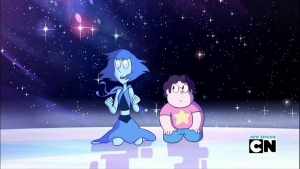
The show’s design displays a variety of tones and moods with its pastel colors, expanding past the style’s typical limitations. The animators find a way to make their art visually interesting even when seldom exploring outside their pallet. This makes the rare occasion where darker or brighter colors are used within the show for dramatic effect all the more memorable, as it creates a fascinating contrast.
And this is what lends Steven Universe’s sets to really stand out once the audience becomes invested. The backgrounds can be very relaxing at times within the show, lulling the audience into a sense of contentment. However, the creators know when to pique the audience’s attention with their sceneries, and use the show’s adventure aspect to their advantage. As the show progresses we see a variety of beautiful and visually stunning backgrounds and set pieces. In fact, with its simple and realistic style, yet bright and soothing colors, it would be no stretch of the imagination to declare Steven Universe as one of the most visually striking shows currently on air. The creators know exactly how to use their environment and style to their advantage.
Much like other popular animated shows, Steven Universe’s art style is also a reflection of its unique story and humor. The prevailing sense of danger one gets from both story and art from Gravity Falls for example is not present in the show, but yet the carefree style of Adventure Time that creates a lack of urgency in most episodes isn’t used either. Instead the story and art come together to give each episode an impact and a stake in the outcome, yet it typically doesn’t create a sense of doom or of overall danger. It’s a good balance that fits the show well, and lends to its specific style.
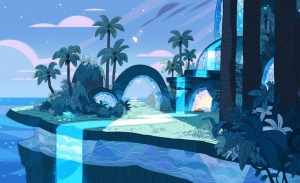 Steven Universe has beautiful backdrops, but rather simple character designs, which is vital in the show’s preferred brand of humor. The designs aren’t quite as elastic as some, but they’re flexible enough to allow a lot of fast paced movement and humor. Much like its art style, the humor of the show can often be much more relaxed. It’s the type of thing that brings a smile to an audience’s face, but will only occasionally make one burst out laughing.
Steven Universe has beautiful backdrops, but rather simple character designs, which is vital in the show’s preferred brand of humor. The designs aren’t quite as elastic as some, but they’re flexible enough to allow a lot of fast paced movement and humor. Much like its art style, the humor of the show can often be much more relaxed. It’s the type of thing that brings a smile to an audience’s face, but will only occasionally make one burst out laughing.
Make no mistake though, the show is definitely humorous. Much like many of the shows that have gotten people talking, it gives unique jokes and has satisfying set ups with gratifying punchlines. Its humor isn’t as random or manic as some cartoons, but it isn’t fully steeped in realism either. It’s a nice balance that allows the show to display a lot of creativity and garner a lot of laughs.
With its calming yet beautiful scenes, Steven Universe has given itself a very distinct style that allows the story and the humor to flow naturally.
Character is Key
Archetypes are common in any show, but they are especially emphasized in cartoons. This is because the shows are typically aimed at a slightly younger audience and creators want to make the characters more easily recognizable to children. This can be very limiting at times, making characters hard to relate to. But the shows that have created a home in so many people’s hearts are often the ones that know how to take an archetype and use it to their advantage. This is a cue that Steven Universe took from some of its successful predecessors, managing to make its characters easy to identify, but still realistic enough to be sympathetic and genuinely likable.

Much like many other cartoons, the show features a young boy as the main protagonist of the series. While the use of children is common in animation it can often be tricky to portray them as realistic. Because series will often use more serious situations, children in adventure stories are frequently more solemn and restrained, doing their best to shoulder a lot of responsibility and ‘save the day.’ While there’s no issue in this characterization on an individual basis, it’s also unrealistic to expect that every child put in that situation would react accordingly. Children don’t always fully understand the gravity of certain situations, meaning they don’t always respond ‘appropriately’ to severe circumstances. Not every child, not even every person, will accept a huge amount of responsibility with an unnatural amount of grace. A good example of a more realistic portrayal might be Lilo in Lilo and Stitch, who is smart to be sure, but isn’t overly serious and still carries many childlike quirks, making her believable.
However many times, when stories don’t take an unrealistically mature approach to child characters, they go the opposite direction, making them overly silly or reckless. They are often treated as the joke of the series, the one always getting something wrong or doing something ridiculous. Again, there are times when this is a legitimate approach. There are children who never take anything seriously, and who are very foolish. But when that seems to be one of two characterizations found for children it can start to become repetitive and uninteresting. This is because most people, and even most children, can’t identify with this. They will see a role model or a funny character to laugh at, but they won’t see themselves.
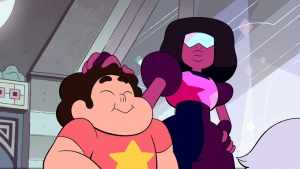
This is part of the reason why specific shows have gotten popular recently. These shows are often the ones that can take a more human approach to characters, specifically, child characters. This makes them more sympathetic to both kids and adults. And Steven Universe is a great example of such.
Steven is the protagonist of the show, so he has a large role to play in the series. He’s always in the middle of the action, going along with every adventure. But he’s always playful and fun loving, providing a fun contrast and making him more easily identifiable. The show works to create a three-dimensional character that not only feels real, but acts like a real kid.
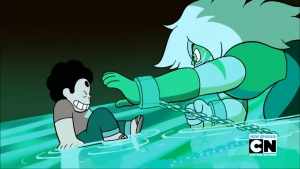
Steven is a very realistic child character. He is funny, relaxed, and often over enthusiastic. He can get caught up in little details and facts (such as snakes not having arms), and can often end up letting his attention drift away from more technical aspects of his role. He can also have very real and child-like doubts. He’s typically very happy-go-lucky and will give any idea a try at least once, but that doesn’t mean that things don’t faze him. He can get angry or annoyed just as a child or person naturally would in certain situations. He can lash out and he can be uncertain. And while he’s usually having fun during missions, he seems to at least grasp that there is some severity to the situations. The fact that Steven manages to be a typical kid, even in an atypical situation really lends itself to making the character seem very natural. Because of this audiences form a more in depth attachment to him, see more of themselves in him, and become even more invested in the show.
Of course the other characters share this quality. The three gems that Steven lives with, Garnet, Amethyst, and Pearl also fall into typical tropes. Garnet is stern and stoic, Amethyst is fun and wild, and Pearl is orderly and intellectual. But the show works to expand past these archetypes as well, unveiling hidden depths and traits one wouldn’t necessarily expect. On top of this, all three come together to try to understand how best to take care of Steven, and though they aren’t always right, it is always heartwarming to watch them try. This gives each of the characters a more three dimensional appeal, even while sticking to these familiar character tropes.
This authentic approach to both Steven and the gems makes them incredibly likable among fans, giving people a reason and way to sympathize and identify with the characters, earning a place in the audience’s hearts.
The Draw of a Good Mystery
A show such as Gravity Falls thrives off of mystery and intrigue. Even if an episode doesn’t revolve around figuring out the central mystery that surrounds the entire story, then it centers on some kind of individual mystery that needs to be solved. It’s proved to be a unique angle for the show and is part of what draws people to it.
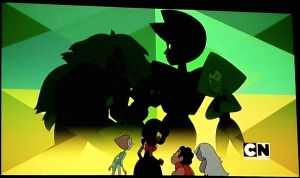 But Steven Universe is a bit different. The show doesn’t focus around any kind of deliberate mystery, at least not from how it first appears. There’s no unknown force or big bad that seems to be affecting their lives every day or interconnects with every mission. Instead the show just drops the audience into a new world, one that seems a bit like ours yet different at the same time. For an entire season the audience simply lives in the world provided to them. But it becomes clear that there are a lot of things that aren’t known. This is when the viewers begin to ask questions. Questions about the history and lore of this fictional world, about the backstories of characters, and about what the deeper meaning behind some character actions may be.
But Steven Universe is a bit different. The show doesn’t focus around any kind of deliberate mystery, at least not from how it first appears. There’s no unknown force or big bad that seems to be affecting their lives every day or interconnects with every mission. Instead the show just drops the audience into a new world, one that seems a bit like ours yet different at the same time. For an entire season the audience simply lives in the world provided to them. But it becomes clear that there are a lot of things that aren’t known. This is when the viewers begin to ask questions. Questions about the history and lore of this fictional world, about the backstories of characters, and about what the deeper meaning behind some character actions may be.
But the creators are good at keeping their cards close to their vests, and only answer small questions one at a time. As the show progresses the creators gradually reveal these underlying questions and build up the history of this world. But it isn’t until the season finale that a significant portion of the pieces all click into place.
It’s an interesting tactic on the show’s part. It’s not trying to thrive off of mystery, that’s not its primary draw. But the mystery is there nonetheless, even if it’s more in the background and smaller details. This of course is a huge draw to older viewers. Often children are more content to just live in the world provided to them, they don’t necessarily need to know the why, but they can enjoy the reveal regardless. However many older viewers do notice these little mysteries and ask these questions. This coupled with an interesting style and realistic characters makes people more likely to come back to the show. They keep watching out of curiosity, hoping to discover a new secret or uncover a new mystery.
And as we’ve learned, the internet loves a good mystery.
The Blatant Approach to Gender and Sexuality
Gender and Sexuality may seem like an odd topic to address in a kid’s cartoon, but it’s no longer as taboo as it used to be. Shows such as Adventure Time and Legend of Korra have tried their best to break the mold, providing strong illusions to romantic relationships between two female characters. Adventure Time especially has tried to take different approaches to gender, something that can be seen in the character BMO, who is portrayed as gender-fluid, one day referring to themselves as he and another as she. Some of these topics have been brushed on in shows such as Spongebob Squarepants, but they’ve always been used primarily for laughs, and rarely for educational or representational purposes.
Because so many shows have been progressively trying to find more ways to discuss these issues without risking getting pulled from the air, there has been a wave of new and inventive ways to try and address gender and sexuality. And those that succeed are often the ones that catch public, specifically internet, attention.
This is probably where Steven Universe stands out among many other popular shows.
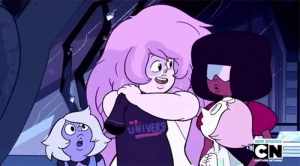
To begin with Steven Universe already has a significant line up of female characters. Of the main four characters, only the title character is male. The supporting cast is also incredibly diverse, both in race and gender. This topic becomes even more interesting though when evaluating the Crystal Gems. Technically the gems are agendered. They are aliens, whose physical forms are actually just stones that act as a sort of ‘heart’. The bodies that they use are hard light manifestations, much like a very solid hologram, meaning that they have no physical gender. But of course that concept can be difficult for children to wrap their minds around, which is part of the reason why even humanoid robots are often portrayed with either masculine or feminine traits. So, in following that trend, it seems that all gems identify themselves as female. This means they use female pronouns, dress feminine, and are designed to look more like women. But don’t be fooled, their genders are entirely of their own construction, which presents an interesting idea in and of itself.
And because the gems have no true gender, yet they all need to be identified with gendered pronouns, the creators use this to their advantage in order to portray different sexualities.
Throughout the show there have been many different instances of romantic intent between the gems. Specifically, the character Pearl often talks about Steven’s mother, Rose, through a romantic lens. From her continued dialogue, as well as from flashbacks where she was shown to be very clearly jealous of Steven’s father, it’s clear that she had unreciprocated feelings for Rose.

There are other points throughout the series as well, such as when Steven and his friend Connie fuse. Fusion is described as being the mental and physical combination of two people, typically gems, to create what essentially amounts to a separate person that makes up the sum of their parts. As someone who is half human and half gem, Steven is able to fuse with Connie, a human, to create someone new. Because Steven is technically male, and Connie female, their new counterpart has no true defined gender. Not in dress, voice, or design. As the episode progresses we see people of both genders express attraction towards ‘Stevonnie,’ none even taking notice of the apparent lack of definitive gender. This episode in particular seems to really sum up how the show handles both gender and sexuality, by treating the two as if they are simply a fluid part of life, and that anything “different” by our standards is simply accepted as a nonissue by the characters.
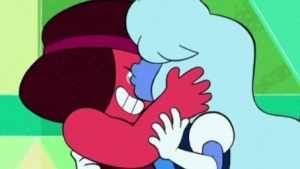
The show truly got noticed for these efforts however in the final episode of the first season, when its popularity really took off. In the episode it is revealed that one of the main characters, Garnet, was in fact a fusion (the name for the person that fusing creates) the entire time. The two ‘female’ gems, Ruby and Sapphire were shown to be very much in love with one another, and clearly romantic. They choose to fuse with one another to create Garnet, in order to be in what is considered the ‘ultimate relationships.’ Because the show was so open with the two’s relationship it gained a lot of attention for pushing past many of the perceived boundaries in addressing same sex relationships.
And because the gems are technically agendered, the creators are able to avoid any problems revolving around the issue. They have a built in ‘out.’
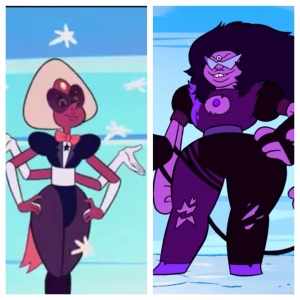
It’s an ingenious set up, and Steven Universe really took off as a result of being willing to experiment with gender and sexuality. Gender identity is a large theme of the show, yet acts as more of an undercurrent than anything ‘in your face,’ making the issue feel very natural. Many shows will use same sex relationships for humor or sexualization, but Steven Universe’s was willing to push past previously established boundaries in order to portray a loving same sex relationship. This makes it unique in its time, and is a large part of what captured the attention of so many new viewers.
The Importance of a Strong Emotional Center
At the end of the day there’s always one surefire way to make an impression on any audience: heart. Mindless and sugar coated cartoons can be enjoyed, no doubt, but there is a reason why they often go ignored or are seen as fun background noise by mature audiences. These shows simply have little to no heart. They’re there to be fun, bright, and funny and little else. There’s nothing to identify with or apply beyond the basic lessons taught to children by any other TV show.
It seems like an obvious statement, but the shows that resonate with audiences are the ones that offer the most heart. Just considering the shows that have gotten popular over the past few years, Avatar: The Last Airbender, Adventure Time, Legend of Korra, Gravity Falls, and even many shows from the past, one can see a definite trend in what really gets people talking. These are the shows that offer mature morals, and present a lot of heart.
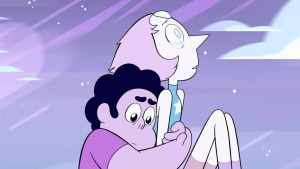
Heart of course is a very vague descriptor, so what would it actually be considered? Do other shows not have emotional moments or sympathetic characters? No, not necessarily. When a show is considered to ‘have heart’ what is meant is that the emotional aspect of the show is always present, even if it isn’t always the focus. So many times in a show there will be softer emotional moments throughout episodes, and in each episode we feel a real emotional investment in whether or not the problem is solved. When something bad happens to a character we don’t just go “aww, poor thing,” instead we really feel their pain and identify with it. “Heart” is what allows the audience to have a stake in the outcome of the show. And ultimately that’s how a good show gets a major following among mature audiences.
And heart is something Steven Universe has plenty of. Much of this plays into characterization, as previously mentioned. But the show allows ample time for an emotional connection with the audience. The show is constantly in touch with its different relationships. The individual relationships between Steven and his caretakers, between the gems themselves, between friends, and even between Steven and his absent mother, are a testament to this. There’s a lot at the creator’s fingertips and they use it to their advantage. The show is full of subtle moments, where the audience can glean a sense of the type of turmoil characters feel from a backhanded comment or an unexpected reaction. But there are other moments as well, when emotions can no longer be repressed, and both the characters and the audience experiences a sense of catharsis. It’s a common tactic in strong storytelling and has proven to resonate with audiences.
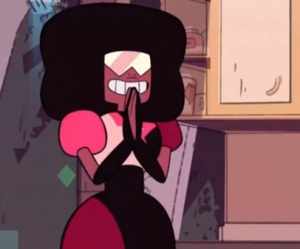 The show’s heart in combination with its style allows it to be as silly or serious as it needs to be. So an episode about a character breaking down isn’t out of place any more than an episode about putting on a play. This is because even within these episodes the show knows how to balance out laughs with sincerity. An episode can focus on heavy subjects but manage to keep its light hearted humor and hope, or it can focus on light topics but always allow room for real emotional stakes in the outcomes.
The show’s heart in combination with its style allows it to be as silly or serious as it needs to be. So an episode about a character breaking down isn’t out of place any more than an episode about putting on a play. This is because even within these episodes the show knows how to balance out laughs with sincerity. An episode can focus on heavy subjects but manage to keep its light hearted humor and hope, or it can focus on light topics but always allow room for real emotional stakes in the outcomes.
Heart can take many forms in shows, especially in cartoons. But it’s clear from its growing popularity that Steven Universe has a distinctive emotional center that it has developed into something unique, identifiable, and, most of all, heartwarming.
With its soothing art, short run time, and fun escapades, its understandable why this show was largely overlooked by the masses for a significant period of time. But when looking at its stunning scenes, unique and genuinely entertaining humor, likable and realistic characters, interesting mystery and plot, progressive gender and sexuality representation, and heartfelt moments, it’s easy to see how it eventually caught the attention of so many people. It took a while for the show to reveal some of its cards, but as soon as it did people flocked to it.
People are attracted to Steven Universe, and cartoons in general, because they offer something unique and creative. Its giving audience’s something new. People who grew up with different shows are looking at today’s animations and saying “I’ve never seen that done before in this way.” And so long as Steven Universe can continue doing that, giving new humor, new stories, and a new world, it will continue to catch the attention of both children and adults alike.
What do you think? Leave a comment.
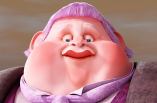

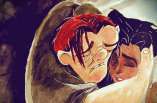








I’m really glad I gave this show some time. Because when the world building hits the fan, oohh woooow hot it hits the fan. Freaking amazing.
Ditto. It took me a few episodes to get into it (plus Frybo and Cat Fingers seriously gave my the heebie-jeebies), but it was well worth it. Even before they really got into the larger plot lines and too much stuff about homeworld, just seeing the characters interact and become more than stereotypes has been so much fun.
This show really snuck up on me. I’m not even sure what made me try it, but I’m glad I did. The delicate balance the writing has is incredible, and it is legitimately heartbreaking at times. It’s subversive, but almost unintentionally, since it doesn’t seem to be pushing any agenda, it’s just a fun, sweet, funny show that quickly wears down your cynicism with sheer innocent joy.
I can agree! I really had to watch quite a few eps but really wanted to give it a chance. I had fallen in love with adventure time, especially for its character depth, so I was not so quickly latched on to Steven Universe but I REALLY am now ☺️
Everytime I watch one of these popular kids shows that have really big followings (Adventure Time, My Little Pony, Steven Universe, seemingly half of the other shows on Cartoon Network, etc), they never don’t feel like kids shows. Quality kids shows, definitely, and I’d be thankful for them if I had kids and was forced to watch their TV shows, but it never really feels like anything I really want to watch. It’s not like I need “adult” content to be entertained, but to me the best kids shows are the ones that you can forget that they’re kids shows and just think of them as shows. And for some reason the knowledge that the show assumes I’m a kid makes it worse. Does anyone else feel that way?
Well for a show that at first looks/feels like a kid’s show but then you very quickly realize that it is very much NOT for kids, check out Rick & Morty. It is a wonderfully fun show that plays with sci fi tropes in a hilarious way. But decidedly NOT a kids show.
Personally I kinda feel the same as you regarding these shows. I hear how awesome shows like Adventure Time and Steven Universe, but I just can’t bring myself to get into them. But I’ll admit that write-ups like this article make me really want to check them out. I certainly don’t think less of people who do like them, there’s just too much cool media out there for me to watch everything.
Wonderful work here! I’ve never watched Steven Universe, but I have watched many of the cartoons listed here. (A:tLA; LoK, Over the Garden Wall.) It’s great to see these shows explore new boundaries. I think a few years ago, a TV cartoon depicting a gay relationship openly would be unheard of, but LoK had Korra and Asami get together, and now it sounds like Steven Universe portrays that very openly.
Steven Universe is currently one of my two biggest obsessions!
Absolutely love this show, watch it with my wife and grandkids.
I am a 55 year old, relatively sane, mature man with a family, and Steven Universe is the only must DVR cartoon on my schedule.
I read the entirety of your work!
The show is fantastic for lots of reasons. One thing I like is the diversity, in character designs, lifestyles, and relationships. Lots of shows just use the same body type as a template for most characters, but in SU, you’d be hard pressed to find two characters who share the same shape.
This show.
I basically binged through episode 50 last week. so its relatively fresh in my head.
I started to watch it last week when I had what can only be described as a shitty Monday. By Friday I had joy in my heart.
The show can be simple but then richly complex and effortlessly swings between the two.
It is the ultimate love note to little brothers an the big sisters that love them, but it is just a joy for anyone to watch.
I tried to like Steven Universe, I really did. I heard all of these awesome things about it, most of which were mentioned in your article. But when I actually watched it, I just couldn’t get past the first few episodes. I was expecting awesome action sequences and gigantic world building, not a kid transforming his fingers into cats…
From what I understand, the awesome parts are few and far between, and most of the show is actually just about Steven being an idiot. It’s the same problem I had with adventure time and Gravity Falls. Maybe they become awesome shows full of deep lore later on, but all I saw was episodic kids shows
I think internet-fandoms always focus on ‘big’ aspects while seemingly dismissing the ‘small’ ones as less important. The silliness you mentioned seems to be integral to what little I’ve seen of the show, yet the internet portrays it as an epic that completely gives itself to social issues.
Is there a point where the original appeal of a show is perverted by the desires of its fandom? I remember watching Adventure Time clamoring for big overarching epics like the Lich storyline, while not appreciating the small yet profound silliness of episodes like “Jake the Brick” and “Thanks for the Crabapples, Giuseppe”.
Hmmm…. Guess what I’m trying to say is that fandoms tend to exaggerate an artwork’s drama amongst themselves, leading to situations such as your own. But at the same time, I’m trying to say that Tolkien-esque epics aren’t the perfect epitome of all media? Not that you did anything wrong in seeking that, I’m just musing why so many people fixate on drama rather than the little things…. Like, can’t something be great without being transcendent?
Also “Thanks for the Crabapples, Giuseppe” is a masterpiece.
The showrunners are quite good with their worldbuilding!
One of the reasons this show is so progressive is because of the depth these characters have in their design. Each character is more than then trope they fall into. Therefore it is easier to identify with them and you want to get to know them more.
Great article.
I’ve been watching this since the leaked pilot with very different art
I absolutely adore SU. I have no shame about watching ‘intended for kids’ shows but, even if I did, I’m sure I’d still want to watch this one and just keep quiet about it.
I just adore the backstory episodes, especially the ones with Amethyst, which always seem to be the most revealing. And when Jasper meets the Gems for the first time, and you get the feeling of how contemptuous the space Gems are for anything that isn’t them. And poor Lapis!
Yep. This article sums up everything I love about the show, from the characters to the storytelling, Steven Universe is an important stepping stone when regarding children animation. Great in-depth article!
There is just something that Rebecca Sugar gets about humanity that the rest of us just fumble about.
There are SO many episodes! Do you know of a good way I can watch the older episodes without paying a boatload to iTunes/Amazon?
I really dig that most of the characters are fun. I also like’d that episode were Connie and Steven fused. It was a really great episode.
This article effectively communicates the tremendous achievement by the creators of Steven Universe to focus on romance, gender, friendship, sexuality,and cooperation in new ways.
I’m hoping in future seasons they might explore a bit more of the earth beyond Steven’s hometown. I think it would be interesting to address how different things are in Steven’s universe (snorts) because of the presence of the Crystal Gems.
Wow just wow
Stephen Universe has overtaken Adventure Time as my favorite current Cartoon Network show. Between these shows, and other really good cartoons like Archer, Venture Bros, Bob’s Burgers, Regular Show, Gravity Falls, and the new TMNT, I feel like we’re in a really good place with cartoons.
When I first got a glance of the show Steven Universe, I didn’t really take to it. It was only until I saw an episode and its beautiful drawings. My friend told me about it and I became more intrigued with the story as well. Especially with Garnet’s character. I intend to watch the episodes this summer.
I’m glad to see new shows like Steven Universe discuss notions of gender more than what I was raised with. To see the shift from a recurrent joke such as in the Powerpuff Girls’ HIM character, to a more complex and thought of conception of identity such as Garnet’s might just allow children (as well as adult viewers of course!) to consider a broader spectrum of identity markers. Overall, I’m pretty glad there is encouragement in accepting diversity, even when behind the metaphor of agendered gems! Love the show!
I love how this show gives great female role models for children and how all kids not just boys or just girls can relate to Steven
A friend of mine at college got my boyfriend and I into this show starting last year. Though I’d heard good things about it before I hadn’t begun watching it till then. It’s such a hilarious, deep and beautifully done show. The artwork even reminded me of the Powerpuff Girls a bit. I’m so glad this show is getting the attention it deserves!
A friend of mine at college got my boyfriend and I into this show starting last year. Though I’d heard good things about it before I hadn’t begun watching it till then. It’s such a hilarious, deep and beautifully done show. The artwork even reminded me of the Powerpuff Girls a bit. I’m so glad this show is getting the attention it deserves!
I definitely agree that cartoons are at its peak right now, and animation in western culture is finally starting to get the respect it deserves!
Steven Universe is one of those cartoons that manages to scratch at me. It may start out like a funny cartoon but then you get bombarded with events that create emotions. Rebecca Sugar and her team really did a great job within the character development and I feel they managed to add something in the series for everyone to relate too.
I’m so glad you mentioned that the gems are all technically agender! I think it’s something important that often gets overlooked and it’s interesting to see this used as an “out” so the gay doesn’t get censored like in say Adventure Time
Nice Article!
This a refreshing analysis. Whenever I hear “fandom,” I have a tendency to associate vitriolic and otherwise vapid characteristics to the context given how any dissent is dragged by legions; but I’m slowly starting to see that bias as well as the positivity of overall outcomes.
It was great reading through this article and exploring some of the things that make this show so lovable! The slow start to Steven Universe surprisingly added to the experience of the show for me as well. Being able to compare the cat fingers episode with Steven’s later outbursts about his mom and the pressures he has to deal creates a contrast that’s both interesting and authentic.
I love this show, especially the latest episodes!
The author of the article mentioned all the Gems as super strong characters, but Connie is also an integral part of the show. She is awesomely geeky, supportive of Steven, but still entirely her own person. She is another strong character, so I hope she gets more screen time in the next few episodes!
I agree with some of the comments that the first few episodes of the show aren’t particularly strong – I almost didn’t keep watching. However, once you get past those, especially to the episodes of the character’s backstories, the show is much more meaningful. I think what really makes this show stand out is, as mentioned, the fluid genders of the characters, but also representing people of colour, like Connie, and actually acknowledging their racial heritage.
I personally like the show for the story. I’m not really into the double meanings and such. I think the show has a good story, good action, and good romances all over. That’s why I like it. It’s a deep show.
I am so in love with Steven Universe, basically because of the reasons that you mentioned. I do think one of the elements that truly makes it stand out from other cartoons is, as you said, the queer representation that it provides. It’s incredible to see queer characters in fully fleshed out relationships that don’t end in tragedy like so many queer relationships on television do. Steven Universe succeeds in presenting queer relationships to children in a healthy, desexualized manner, which is something that I think is critical especially for queer youth. I also love how it deals with concepts such as healthy or abusive relationships or consent through things like fusion and starts teaching kids about important topics in a way that makes sense to them. Steven Universe is just… so good in so many ways.
I won’t lie, I was a little worried when I saw the title of this article, afraid that the focus would lie in the negative aspects of the show’s fandom, but I was pleasantly surprised to find a well-thought out essay about the show’s strengths and unique storytelling! Steven Universe is innovative and groundbreaking in so many ways, and you’ve done a very eloquent job of pinpointing them! This was a wonderful read, thanks for writing!
To me, a good question is: can a show even succeed/become popular anymore WITHOUT harnessing social media in a way to further its popularity? With Steven Universe, it’s a show I almost certainly never would’ve gone out of my way to watch, had I not heard about it so frequently on Twitter — and since there is no such thing as a “water cooler show” anymore, it seems like the best way to assure a weird, quirky show connects with people is to make sure it has a huge following online at the very least.
I had no idea the alternation of colour in an ordinarily pastel tinted show was so prominent a tool to signal impending suspense and intrigue… I will pay more attention to it during my third watch through 😀
I absolutely love the manner in which Steven Universe deals with gender and sexuality. Nether is glorified or overstated to seem significat or ‘different’ within the show’s world and characters reactions to such topics. It’s normalised and honest and truly beautiful. There’s no characters with big traits or arhtypes that are so heavily dependent on their gender or sexuality. There’s no: they are strong ‘as a woman’ or ‘as a man’ or ‘as a boy, child, etc.’ And all of this is so so beneficial to audiences of all ages because we too adopt these perspectives on the topic of gender and sexuality. Oh, and can I just say the show’s very very clever work around on current cartoon restrictions about these topics is just so smart and awesome 😂👌